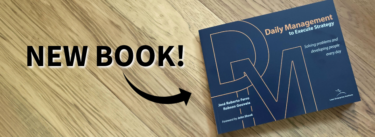Culture change takes care, patience, a bottomless energy source, and an iron will to succeed. Oh, and let’s not forget the degree in psychology. Or maybe it just feels this way. The point is: culture change typically isn’t greeted with open arms unless there is a crisis to provide a sense of urgency.
Still, I’ve noticed there are a few “Do-Not-Pass-Go” items that must be a part of any successful lean culture change initiative.
Leadership Involvement. Rather, let’s say: Commitment. Here’s a fable for you: A hen and a pig were talking in the barnyard one day. The hen was so proud and talking on and on about how glad she was that she and the pig could help the farmer and his family by supplying them with ham and eggs for their breakfast. The pig, however, was less enthusiastic about it. He replied, ‘That’s easy for you to say; you are just involved. For me; it’s a total commitment.”
We hear the words “leadership involvement or engagement” (which can be confusing and ambiguous, even to leaders) and we don’t know what engagement means. Perhaps we are using the wrong word. Leadership commitment is a crucial element that, if missing, spells certain doom for your change initiative. Consciously or not; we follow leader examples. What we perceive of their actions often determines what we prioritize and how we behave. If your leadership team can’t demonstrate a commitment to change, neither will you. Why should you?
LeanCor has authored an excellent book called People that helps leaders understand what is expected of them when they hear: “We need you to be committed to continuous improvement.”
Leadership sets the tone, vision, expectations, and direction of the organization by demonstrating active participation, genuine interest, and transparency to the company. By conveying that something is important, change adoption rates increase and staff interest will be elevated. Just elevating the level of acknowledgement is over halfway to the solution.
Education. Learning is not something that we can clap our hands together one day and say: “Well, that’s done!” Neither is continuous improvement. As da Vinci said: “Study without desire spoils the memory, and it retains nothing that it takes in.” In other words, if there is no desire to learn, then all of the available education in the world will not make a difference. This is where leadership’s role in driving the change hand-in-hand with communicating the why behind the need to change is critical. If there is no explanation given of why the education or change is necessary, then the initiative just becomes waste in the minds of the staff. After all: things have been working ok so far, right? Simon Sinek discusses the importance of “why” in his Ted Talks: “How Great Leaders Inspire Action”.
Also, just presenting a concept once is a good way to pass time if you have plenty of time to spare, but it’s not an effective way to help people retain the information. Do your team members a favor and repeat lean concepts from different perspectives, ask them for their thoughts, and make certain that they participate in the learning. Active learning is the best way to retain information. Be open to learning new concepts yourself! People will naturally resist change even if the change is a glaringly positive one. So, start with the basics of ‘why’, principles of the change, and then move to the tools to get the change done. Wash and repeat.
Cultural Dynamics. These include things like morale, average employee perspective, maturity level / professional behavior, accepted participation level, business mindset, level of accountability, and at least 25 other key factors. Basically: if you want to change the culture, you must understand it first in order to grasp where one must begin in the education process. If there is a lack of accountability, then be prepared to coach and mentor on the subject. I’ve personally made the mistake of assuming that a culture was at a certain professional maturity level, only to wonder later why it took so long to make change happen.
Be prepared to suggest basic professional-level courses, even for management. Have your leaders previously benefitted from any formal professional education or did they receive the position without any training? This happens more than you think! At what leadership level do they perform? What is the communication like in the company: Good, Fair, Poor, Non-Existent? Are there any standards of work? What expectations, verbal and non-verbal, are set by management? Does your company promote the ‘fire-fighters’, or the team players? Again, we follow our leaders, so if the management teams exhibit poor leadership skills, staff performance will suffer and the culture change will be an uphill battle. In addition, interviewing and assessing tenured employees can be critical to your culture change as they are often unofficial leaders within their circle of influence.
Sometimes you have to dig down to foundational level concepts to ensure that your continuous improvement / Lean culture change is a success. Don’t be discouraged – what you are doing is critical for the company’s development and business health. Their future will be much brighter for your efforts.
Leadership involvement, education, cultural dynamics. Check, check, check. All of this sounds easy enough, right? Of course not. Paying attention to all of these things, let alone trying to change them, is challenging. But take a deep breath: just the fact that you’re aware a culture change is needed makes you light years ahead of everyone else. Step back and appreciate the current collective mental state to determine what lean concepts you must educate employees on first (with leadership present!) in order to take that next step forward.






Well said and timely for myself. Thank you.